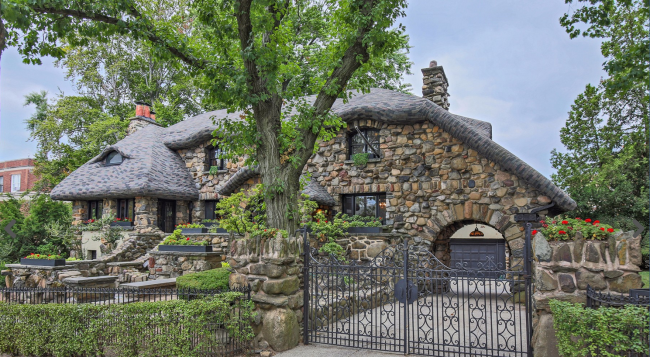Senator Street in Bay Ridge: A historic block without landmark protections

Senator Street in Bay Ridge is lined with impressive brownstones.
Marjorie Cohen
Two short blocks from the just-renovated Bay Ridge Parkway subway stop on the R line, you’ll find yourself on one of New York City's lesser-known brownstone blocks. Located just off the corner of Fourth Avenue, the 300 block of Senator Street is the only block in Bay Ridge with brownstones on both sides of the block.
At first glance, all of the Senator Street houses look exactly alike, but take a closer look and you’ll notice a few subtle features that distinguish one from the next. All but two of the 40 houses in the row were built by the same firm. Brownstone was beginning to go out of fashion by 1906 when the developers began to build the houses on spec.
At the turn of the century, Bay Ridge was starting to attract middle class buyers looking for this kind of place at a price they could afford. Built as two-family houses, unlike the single-family versions in other parts of Brooklyn, these buildings gave the owners the chance to live comfortably, indeed almost elegantly, on the first two floors and manage their expenses by renting a one-bedroom apartment on the third floor.
Senator Street was named after one of the most influential people in the borough’s history
The “senator” referred to in the street name was Henry C. Murphy, one of the most prominent Brooklynites of his time. Murphy’s New York Times obituary in 1882 is headlined "The End of a Busy Life.” No hyperbole there. Murphy was the mayor of Brooklyn some 50 years before the city was incorporated into New York City. He was a congressman, a state senator, and an ambassador to the Hague. What’s more, he co-founded and edited the Brooklyn Eagle newspaper.
As state senator he is best known for drafting the bill that kick-started construction of what was then called the East River Bridge, now the Brooklyn Bridge. He is said to have signed the bill in the library of his Bay Ridge mansion. Murphy was a “constant and comprehensive reader,” according to his obituary, and had one of the “best private libraries in the country, more than 5,000 volumes.”
Murphy was also instrumental in renaming Bay Ridge which, until the mid 1800s, was known as Yellow Hook. The change was made for public relations purposes: Yellow Hook (a name chosen by the Dutch in the 1600’s because of the yellow clay of the area) was thought to conjure up thoughts of the yellow fever epidemic that had ravaged the city. The new intended name may actually have been "Bay Bridge," but that is a story for another time.
In the early 1900s, the neighborhood’s lavish mansions and summer houses gave way to modest places for the less well-off
As happened time and time again in New York City history, when public transportation was extended to Bay Ridge, the neighborhood became ripe for speculative building. Brooklyn architect Frederick Eisenla predicted that his Senator Street houses would be a hot commodity once the Fourth Avenue subway extension to Bay Ridge was completed. His houses were completed by 1912, and the nearby station opened four years later. He was right.
Eisenla designed the Senator Street row in the Renaissance Revival style. The houses are set back from the street, have bow fronts, small front yards, high stoops, and garden entrances. The lion heads carved at the top of the stone railings are exactly the same on each house, but the embellishments on the columns on either side of the doorways and the garlands, heraldic emblems, swags, and other details carved into the facades are slightly different on each house.

Eisenla’s firm also designed houses in Park Slope and Sunset Park, and built multi-family buildings for the Finnish Home Building Association, a group of Finnish immigrants who pooled their money to create the first not-for-profit co-op in NYC. The Brooklyn Eagle described Eisenla's firm as being “workaday builders and architects, not caring to be original, but skillful in exploiting the superb taste of today.”
The park at the end of Senator Street was once the site of a munitions magnate’s sprawling estate
A part of the land that is now Owl’s Head Park was once the site of Henry Murphy’s estate. Murphy sold it right before he died to Eliphalet W. Bliss for $80,000. Bliss was an enormously successful businessman who owned a two-block long complex on the Sunset Park waterfront, and workshops in what is now Dumbo that produced torpedoes, tools, dyes, and sheet metal presses. The cast iron gates at the Colonial Road entrance to the park, retrieved from a Parks Department storage unit and reinstalled in 2002, have Bliss’s initials on them.
Bliss bought plots adjacent to the land that had belonged to Murphy and built a long drive, a lodge, stables, and an observatory tower. Over several decades, Bliss went back and forth with officials offering to sell his land in order to make a park out of it, but the deal never happened in his lifetime.
Finally, in his will, Bliss offered the land to the city for a reduced price on the condition it be turned into a public park. By then the acreage had shrunk to about half the size Bliss had originally proposed. The offer was accepted but once the city paid for the land there was no money left over to maintain the green space, according to Henry Stewart, who leads tours of the park.
In the 1920s, the BMT began construction of a subway that was meant to connect the Fourth Avenue subway to Staten Island, tunneling under the park and the Narrows. Obviously the project never happened, but in 1923, Mayor John Hylan broke ground in Owl’s Head Park and touted the project as “one of the greatest improvements the great city of New York has ever undertaken.”
Lacking resources, the property became blighted and it was not until 1940 that the present-day park was created, under the charge of then-Parks Commissioner Robert Moses.

An effort to obtain city landmark status for the block seems to be stalled
In 2002, the block was added to the National Register of Historic Places as the Senator Street Historic District, but that designation doesn’t guarantee the exteriors of the homes on the block will stay intact. For that to happen the city Landmarks Preservation Commission must give its own designation. Although there have been remarkably few alterations made to the exteriors of the houses over the past hundred years, that can change at any time without the protection of the LPC. That is why in 2006 some residents of the block, supported by the Historic Districts Council and Community Board 10, applied for LPC designation.
Simeon Bankoff, executive director of the Historic Districts Council, says he can’t explain why the LPC never acted:
“Senator Street is a completely beautiful block which should be designated. The buildings are great, the community was behind it, the research was done and there are no LPC Historic Districts in [southern] Brooklyn. It was an easy win for [the LPC], and for reasons of their own they chose not to act.”
Want to live on the block? A condo and a rental apartment nearby are on the market
One of Eisenla’s original row houses, number 343, has been gut-renovated and converted into two condos. The larger unit, listed for $1.2 million, just went into contract. The lower-level two bedroom is still available. It boasts 1,800 square feet, a 700-square-foot garden, and a finished rec room. Price: $975,000.
A rental not far from Senator Street at 517 79th St., is in a brick two-family house built in 1925. It’s on the second floor and has three bedrooms, an open kitchen, and a terrace. Price: $2,600 a month.
You Might Also Like



























